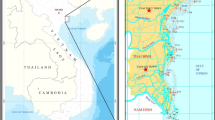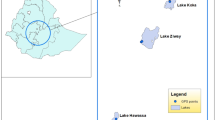Abstract
The mangrove wetland in Dongzhai Harbor, Hainan Province was taken as a research area for the collection of samples of sediments and other media. The Pd content was determined by microwave digestion and inductively coupled plasma mass spectrometry (ICP-MS), and the factors influencing the accumulation of the platinum group element (PGE) Pd in mangrove wetland sediments were discussed. The results showed that the average concentrations of Pd in the surface sediments, plants and water of mangrove wetlands were 4.81 ng/g (1.51~8.15 ng/g), 0.94 ng/g (ND ~ 4.34 ng/g), and 0.11 ng/mL (ND ~ 0.27 ng/mL), respectively. Pd was mainly concentrated in the sediments, which absorb most of the Pd in the mangrove wetland environment. From the wetland estuary to offshore, the sediment Pd showed a decreasing trend. The land origin of Pd in mangrove wetland was explained. Extending from the mudflat to the mangrove, the “V” shape becomes the main distribution pattern of sediment Pd, which is higher in the mudflat and forest, and lowest in the forest edge. In the vertical direction, the average concentrations of Pd were the highest at the surface (10–20 cm) and decreased with increasing depth. Pd concentrations in the sediment in the dry season was higher than that in the wet season. Pd was significantly correlated with pH and Eh. This study can help clarify the environmental geochemical process of PGEs in mangrove wetlands and has important scientific significance and practical value for the environmental protection and utilization of mangrove wetlands.





Similar content being viewed by others
References
Ali MM, Ali ML, Islam MS et al (2016) Preliminary assessment of heavy metals in water and sediment of Karnaphuli River, Bangladesh. Environ Nanotechnol Monit Manage 5:27–35
Al-Kahtany K, El-Sorogy A, Al-Kahtany F (2018) Heavy metals in mangrove sediments of the central Arabian gulf shoreline, Saudi Arabia. Arab J Geosci 11(7):1-12
Birke M, Rauch U, Stummeyer J et al (2018) A review of platinum group element (PGE) geochemistry and a study of the changes of PGE contents in the topsoil of Berlin, Germany, between 1992 and 2013. J Geochem Explor 187:72–96
Cabral L, Júnior GV, Pereira ST et al (2016) Anthropogenic impact on mangrove sediments triggers differential responses in the heavy metals and antibiotic resistomes of microbial communities. Environ Pollut 216:460–469
Feng J, Zhu X, Wu H et al (2017) Distribution and ecological risk assessment of heavy metals in surface sediments of a typical restored mangrove-aquaculture wetland in Shenzhen, China. Mar Pollut Bull 124(2):1033–1039
Fontana LF, Crapez MAC, Junior AGF et al (2012) Characterization and distribution of polycyclic aromatic hydrocarbons in sediments from Suruı´ mangrove, Guanabara Bay, Rio de Janeiro, Brazil. J Coast Res 28(1A):156–162
Ji YN, Zhao ZZ, Wu D et al (2016) Distribution and bioavailability of heavy metals in mangrove deposits in dongzhai harbor, Hainan. J Appl Ecol 27(2):593–600
Kaewtubtim P, Meeinkuirt W, Seepom S et al (2016) Heavy metal phytoremediation poential of plant species in a mangrove ecosystem in Pattani bay, Thailang. Applied Ecology & Environmental Research 14(1):367–382
Krauss KW, Cormier N, Osland MJ et al (2017) Created mangrove wetlands store belowground carbon and surface elevation change enables them to adjust to sea-level rise. Sci Rep 7(1):1030
Li CR, Liu K, Lin JQ et al (2013) Characteristics of rainfall runoff pollution on different underlying surfaces in Haikou city proper. China environmental monitoring 29(5):80–83
Li H, Lu J, Li QS et al (2016a) Effects of freshwater leaching on potential bioavailability of heavy metals in tidal flat soils. Environ Geochem Health 38(1):99–110
Li R, Chai M, Qiu GY (2016b) Distribution, fraction, and ecological assessment of heavy metals in sediment-plant system in mangrove forest, South China Sea. Plos one 11(1):e0147308
Liu YY, Liu HF, Zeng HH et al (2014) Effects of weather factors on road dust PGEs accumulation. Chinese Environmental Science 34(2):289–294
Liu S, Shi X, Yang G et al (2016) Concentration distribution and assessment of heavy metals in the surface sediments of the western gulf of Thailand. Environ Earth Sci 75(4):346
Liu YY, Fu B, Shen YX et al (2018) Seasonal properties on PM1 and PGEs (Rh, Pd, and Pt) in PM1. Atmospheric Pollution Research 9:1032–1037
Mihaljevič M, Galušková I, Strnad L et al (2013) Distribution of platinum group elements in urban soils, comparison of historically different large cities Prague and Ostrava, Czech Republic. J Geochem Explor 124(124):212–217
Mrutu A, Nkotagu HH, Luilo GB (2013) Spatial distribution of heavy metals in Msimbazi River mangrove sediments in Dar Es Salaam coastal zone, Tanzania. International Journal of Environmental Science 3(5):1641–1655
Rajagopal K (2016) Analysis of heavy metals accumulation in mangroves and associated mangroves species of Ennore mangrove ecosystem, East Coast India. Indian Journal of Science & Technology 9(46):1–11
Sen IS, Mitra A, Peucker-Ehrenbrink B et al (2016) Emerging airborne contaminants in India: platinum group elements from catalytic converters in motor vehicles. Appl Geochem 75:100–106
Sundaramanickam A, Shanmugam N, Cholan S et al (2016) Spatial variability of heavy metals in estuarine, mangrove and coastal ecosystems along Parangipettai, southeast coast of India. Environ Pollut 218:186–195
Suoranta T, Niemelä M, Poikolainen J et al (2016) Active biomonitoring of palladium, platinum, and rhodium emissions from road traffic using transplanted moss. Environ Sci Pollut Res 23:16):1–16)12
Sutherland RA, Pearson GD, Ottley CJ et al (2015) Platinum-Group Elements in Urban Fluvial Bed Sediments—Hawaii. In: Platinum-group elements in urban fluvial bed sediments—Hawaii. Springer Berlin Heidelberg 163-186
Usman AR, Alkredaa RS, Alwabel MI (2013) Heavy metal contamination in sediments and mangroves from the coast of Red Sea: Avicennia marina as potential metal bioaccumulator. Ecotoxicology & Environmental Safety 97(5):263–270
Vidya P, Patil RK (2016) Heavy metal distribution in mangrove sediment cores from selected sites along western coast of India. Journaf of Threatened Taxa 8(11):9356–9936
Wang P, Zhao ZZ, Ma RL et al (2014) Accumulation characteristics of heavy metals in mangroves of intertidal zone in northern Hainan Island. Journal of ecological environment (5):842–846
Wiseman CL, Hassan PZ, Zereini F et al (2016) Platinum group element and cerium concentrations in roadside environments in Toronto, Canada. Chemosphere 145:61–67
Zereini F, Wiseman CLS, Poprizki J et al (2016) Assessing the potential of inorganic anions (Cl−, \({\mathrm{NO}}_3^{-}\), \({\mathrm{SO}}_4^{2-}\)and \({\mathrm{PO}}_4^{3-}\))to increase the bioaccessibility of emitted palladium in the environment: Experimental studies with soils and a Pd model substance. Environmental Pollution Part B 220:1050–1058
Zhang ZW, Li JL, Sui T et al (2017) Research progress of organic pollutants in mangrove wetlands in China. Ecological science 36(5):232–240
Acknowledgements
This research was supported by Hainan Natural Science Foundation (418MS049), National Natural Science Foundation of China (41867060), and the Key Research and Development Program of Hainan Province (ZDYF2019131). We thank Xing Yang and Changdong Zhou, 2014 Undergraduate of College of Geography and Environmental Science, Hainan Normal University, and other students help to complete the sampling work.
Author information
Authors and Affiliations
Corresponding author
Ethics declarations
Conflict of interest
The authors declare that we have no conflict of interest.
Additional information
Publisher’s note
Springer Nature remains neutral with regard to jurisdictional claims in published maps and institutional affiliations.
Rights and permissions
About this article
Cite this article
Liu, Y., Ji, C., Fu, B. et al. Factors influencing the accumulation of Pd in mangrove wetland sediments in Dongzhai Harbor, Hainan, China. J Coast Conserv 23, 1039–1045 (2019). https://doi.org/10.1007/s11852-019-00710-1
Received:
Revised:
Accepted:
Published:
Issue Date:
DOI: https://doi.org/10.1007/s11852-019-00710-1




